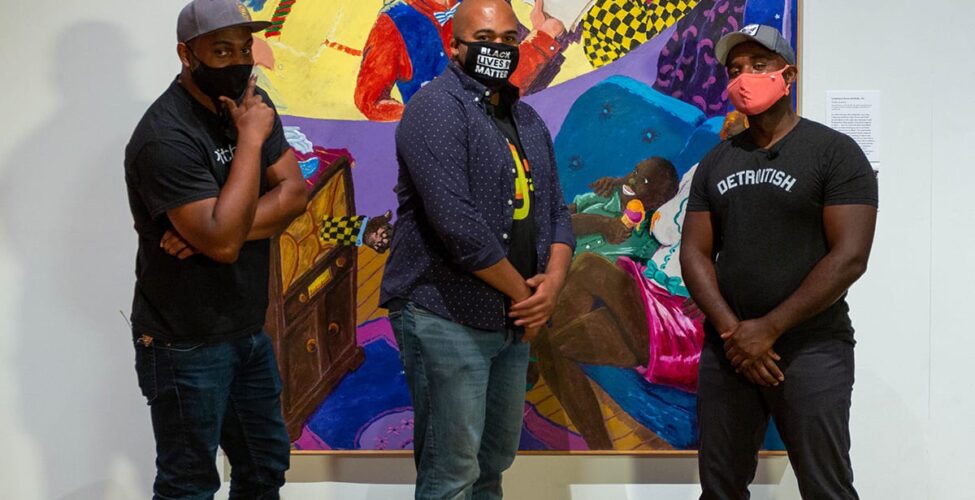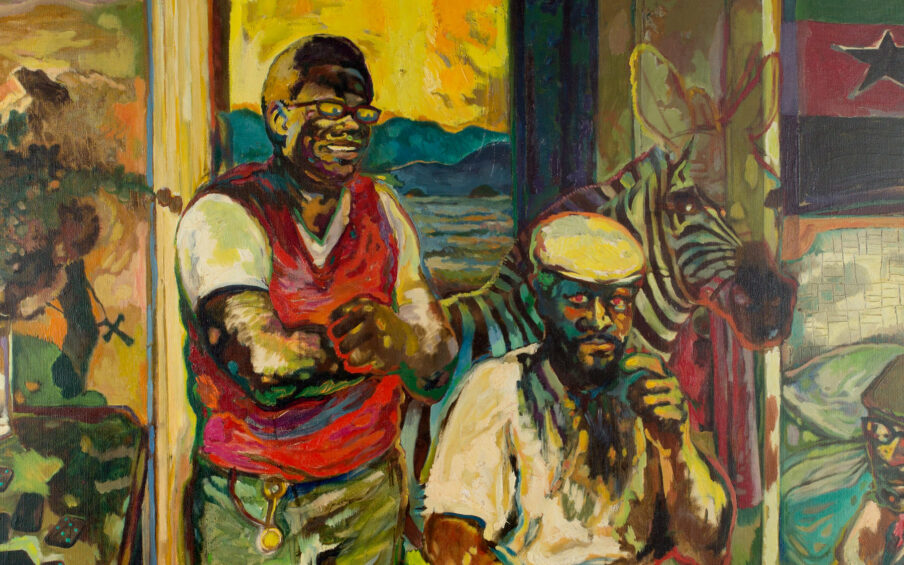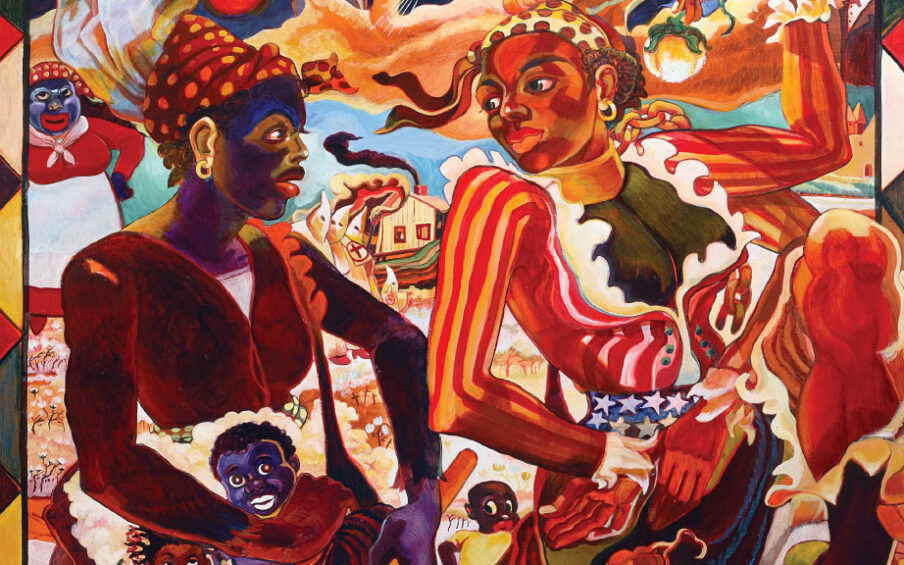We are pleased to offer this guest post by the members of improv trio Broke Gravy, a community partner for Art and Race Matters: The Career of Robert Colescott, which closed earlier this month. In this guest blog post, the trio reflects on the exhibition’s final public program, Perspectives on Colescott: Identity, Satire, and Politics, a December 10 panel discussion looking at Robert Colescott’s use of identity, satire, and politics.
“If you decide to laugh, don’t forget the ‘humor is the bait,’ and once you’ve bitten, you may have to do some serious chewing. The tears may come later.”
These are the words of artist Robert Colescott in regards to how folks find humor in his art. The truths contained in his work feel universal and yet, as Black artists we feel them more fully. We may not paint physical pictures as Colescott did but are driven to fill the stage with vivid imagery nonetheless. Our canvass might be comedy but the truth, warts and all, is the dye that we use to create an original work of art each time you experience a Broke Gravy Show.
These are just a glimpse in each of our individual takeaways from exploring the artwork of Robert Colescott.
Chris Williams, Broke Gravy
I am neither an art historian nor an art critic. Truth be told, I gravitate more towards old bones and prehistoric animals when it comes to museums, but Robert Colescott’s paintings are a bit of a wild card for me and based on the comment section during this event he’s a wild card for others too. Do I like his works? No. Do I hate his works? No. Am I indifferent about his works? Absolutely not. So then where does that leave me? I can’t even be in the middle with Colescott. His paintings are a paradox, and human beings don’t tend to like paradoxes. Struggling with Colescott’s artwork on a live, recorded feed was an act of vulnerability. We live in the age of comments. People love to comment on things—, hell, I love to comment on things, and I’m sure there will be comments about what I’m writing now. I don’t think our ability to quickly comment on things is bad but I do wonder if it’s always good. Sometimes, having to sit with something helps to more fully shape a response. If I only listen to react then I would miss a lot of important information. When I look at the works of Robert Colescott I do have an immediate reaction. However, instead of turning my head and walking away or disparaging the scene in front of me, I steel my resolve. I listened to the insightful comments of my fellow panelists and I sat with their words like I sat with Colescott’s brushstrokes. They helped to shed light on certain things I had completely missed in his paintings. Do I hate Robert Colescott’s work? No. Do I like Robert Colescott’s work? No…but damn is he a great artist!
Leon Anderson, Broke Gravy
Everytime I look at a work of Robert Colescott, who for full transparency I had never heard of before this exhibition at PAM, I am presented with the question of, ‘who is this for?’ As I mentioned during the “In Dialogue” round table, I have drastically different feelings when I am observing these works on my own, amongst a small group of people of color or in a sea of strangers the majority of whom are white. While outwardly irreverent in many ways, Colescott’s works challenge the viewer to ask themselves where does the truth lie in their perspective, presumptions and preconceptions of Black people in America. It’s really easy when looking at a Sambo stereotype to immediately lock that image in the past, and convince ourselves that we have expanded beyond this pejorative imagery. However, the opportunity comes in sitting in the uncomfortable truth that this view of the Black human being is still prevalent in our every day.
Eric Simons, Broke Gravy
I’ve always loved discussion. Music, literature, politics, food, sports, and on and on. When the individuals all arrive with compassion, respect, and a bit of open-mindedness—growth and new discoveries can be just around the corner. In my hunt for art, typically, one visual artist might get the better part of a long afternoon at the museum, but with Robert Colescott I was fortunate to be given several hours across several months. And given the personalities I was fortunate to be surrounded with, I was exposed to new insights, perspectives, and queries about Colescott’s work, the world, and myself. Like any great artist, Colescott engaged my mind in ways I wasn’t prepared for, taking me down an endless number of paths. And behind these paths, I found myself laid vulnerable—which is why it saddens me to have read how many of the more or less anonymous commenters sought to try and control the narrative of the night. I witnessed the denial of the experiences of myself, my partners Chris and Leon, or our guests Chevonne Ball and Nishat Akhart. I witnessed people continuously contort themselves into their safe and privileged point-of-views, skirting culpability with every keystroke that opened with ‘As a white person…’ Are the experiences of all of these commenters valid? Of course, but that doesn’t necessarily make them relevant. As a person of color, I’ve had to learn to be a master of reading the room, adjusting to context, code-switching for other’s comfort and my own safety. Somehow, with a work of art that permeates from a place of grappling with the space BIPOC are given (or more accurately not given), I was dismayed to witness so many people trying to grasp onto their privileges at a Zoom-broadcast art dialogue. This is nothing new to BIPOC, and yes, there were more people in the comments sparking thoughts and swimming in new perspectives, but the tide of white supremacy still crashed against progress.
I long for the day we are able to move beyond the worldwide isolation of COVID-19 and hold more events like this in-person. There is too much energy, truth, and vulnerability filling the room, aching to burst if people will open their ears and unharden their hearts. One day, people will take responsibility for their action and/or inaction. One day, I hope.
Watch:
View PAM’s Online Exhibition: Art and Race Matters: The Career of Robert Colescott



